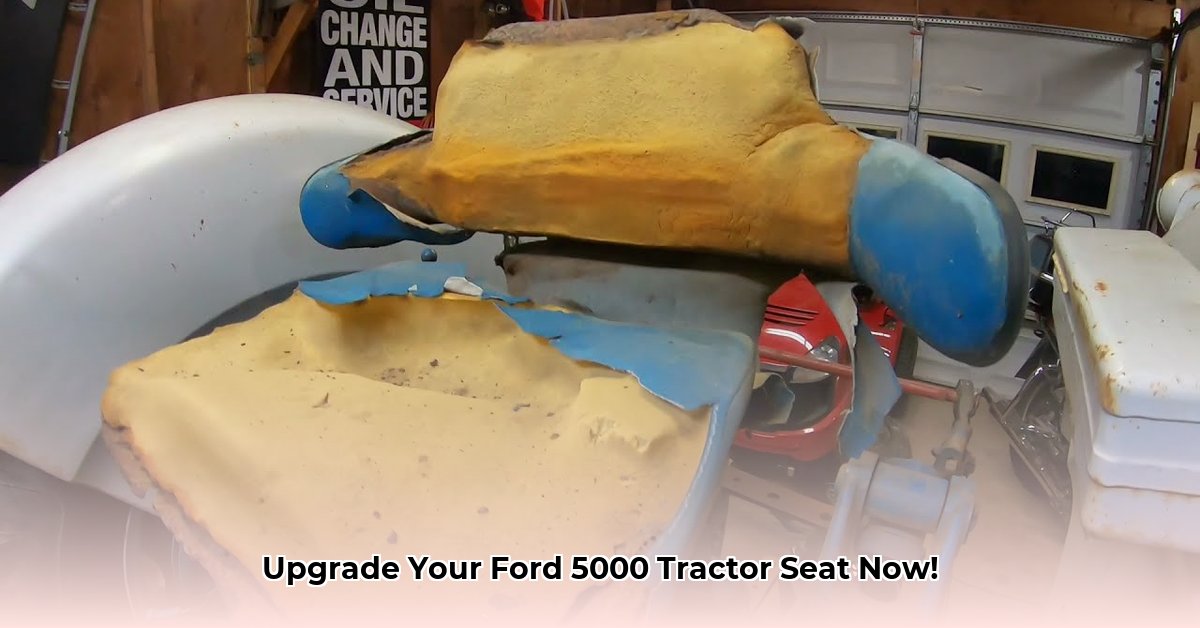
Replacing your Ford 5000 tractor seat shouldn't be a frustrating ordeal. This comprehensive guide simplifies the process, helping you find the perfect replacement, whether it's a brand-new original equipment manufacturer (OEM) part or a reliable used option. We'll navigate the complexities of part numbers, compatibility issues, and sourcing strategies, ensuring a smooth and efficient repair. For additional troubleshooting, check out this helpful resource on common Ford 5000 problems.
Identifying Your Ford 5000 Tractor's Specifications
Before purchasing a replacement seat, precise identification of your tractor's model and specifications is paramount. Incorrect identification can lead to costly mistakes and compatibility issues. Think of it like buying clothes – the wrong size simply won't fit.
Locate the Data Plate: Your tractor's data plate contains crucial information, including the model number and serial number. This plate is usually located on the side or back of the tractor. Photographing the plate ensures you have an accurate record of this vital information.
Consult the Owner's Manual: If you still possess the original owner's manual, it's an invaluable resource. The manual will provide detailed specifications, including the correct seat model number. This is your first stop in the search process.
Examine the Existing Seat: The seat itself might contain clues. Check the base or underside; you might discover numbers or codes that assist in identifying the correct replacement. This method works best if the seat is still intact.
Accurate identification at this stage is critical for success. Failing to accurately identify your tractor model may lead to compatibility issues, necessitating further work and expense.
Decoding Ford 5000 Tractor Seat Part Numbers
Ford employed varying part numbering systems throughout its production history. This can lead to significant confusion. Each digit within the part number often holds specific meaning, referencing model year, features, and other specifications. This section aims to simplify this complex system.
This table provides a starting point for decoding common Ford 5000 tractor seat part numbers. Remember, this is not exhaustive, and further research might be necessary. Always cross-reference with your tractor's specifications before committing to a purchase.
| Part Number | Likely Compatibility | Notes |
|---|---|---|
| E7NN420AA | Multiple Ford 5000 models | Common part number, though compatibility must be verified. |
| E7NN400GA | Specific Ford 5000 models, potential industrial model fit | Requires careful cross-referencing with your tractor's details. |
| D8NN400BABB | Older Ford 5000 models | May be harder to source; consider used options. |
| Other Numbers | Requires further research | Online forums and specialist parts suppliers can be helpful. |
Don't be discouraged by the seemingly cryptic nature of these numbers. With careful investigation and the use of online resources, deciphering the correct part number is achievable.
Sourcing Your Replacement Ford 5000 Tractor Seat
Once you've identified the correct part number, it's time to source your replacement seat. Several options cater to various budgets and requirements. Choosing the right source requires careful consideration.
New OEM or Aftermarket Seats: Agricultural parts suppliers often stock both original equipment manufacturer (OEM) and aftermarket replacement seats. OEM parts guarantee a perfect fit, but they usually come with a higher price tag. Aftermarket options present a more budget-friendly alternative, though compatibility requires careful verification.
Used Tractor Seats: Online marketplaces like eBay and dedicated used farm equipment sites offer a cost-effective option. However, used seats necessitate thorough inspection for damage or wear and tear before purchasing.
Local Dealers and Salvage Yards: Don't overlook local sources. Tractor dealerships and salvage yards may have used seats in stock or possess valuable knowledge to aid your search. They can be a wealth of local information which can significantly streamline the process.
Choosing the right source is critical. While a used seat presents significant cost savings, it’s crucial to thoroughly assess its condition. Reputable suppliers, whether online or local, are invaluable in avoiding counterfeit parts.
Installing Your New Ford 5000 Tractor Seat (A Quick Guide)
Installing your new seat involves several steps. While a detailed explanation is beyond this guide's scope, here's a summarized approach:
Safety First: Always disconnect the battery before working near electrical components.
Consult Your Owner's Manual: Your owner’s manual contains specific installation instructions and diagrams tailored to your tractor model. This is your primary resource.
Use Appropriate Tools: Utilizing the correct tools is critical for a safe and efficient installation.
Seek Professional Assistance: If you're uncomfortable performing the installation, consider contacting a qualified mechanic. This is a small investment that prevents potential damage and ensures a safe outcome.
Addressing Common Problems
Even with careful planning, some challenges can arise. Here are some common problems and suggested solutions:
Incorrect Part Number: Verify the part number against your tractor's documentation multiple times. Contact the supplier if you have any doubts.
Compatibility Issues: Minor differences in design can lead to compatibility problems. Inspect the mounting points carefully.
Used Seat Issues: Thoroughly inspect used seats before purchase. Look for wear, tear, and potential damage, especially to the seat's frame and suspension elements.
Remember, a successful seat replacement depends on careful attention to detail and a methodical approach. These preventative steps will significantly contribute to a positive outcome.